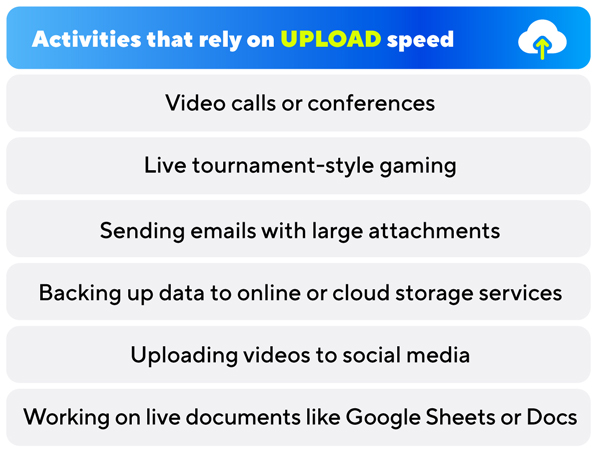Upload vs download speeds: what’s the difference? |

Ever waited hours for a file to upload as you send it over a file sharing system? Or had to switch your camera off on a video call because your connection had some serious lag? We’ve all been there!
With the amount of time we all spend online, uploading is now as important as downloading. So why do fast upload speeds matter?
What’s the difference between upload and download speed?
The main difference between upload and download speed is the direction which data is travelling. Upload speeds are the speed at which data is travelling from your device (e.g. laptop or phone) to the internet. For example, when you’re uploading videos or attaching files to emails. Download speed is the speed at which data is travelling from the internet to your device. For example, when you’re downloading a podcast or streaming TV. It’s important to be aware that some broadband providers offer much slower upload speeds than downloads, so always check the details of your package before ordering. Hyperoptic offers equally fast uploads and downloads on all our full fibre broadband packages above 150Mb.

What is upload speed used for?
Your upload speed is how quickly data travels between your computer and your network. Uploading is used for anything from streaming video calls and conferences to file or photo sharing on the cloud. So if you’re a gamer, streamer or homeworker, a fast upload speed matters to you. The faster your upload speed, the clearer your calls and the sooner you’re getting things done!
Just like downloads, uploads are measured in megabits per second, or Mbps. According to Ofcom, there has been a 54% increase in the mean average upload speed in 2020, with the UK average upload speed as of November 2020 at 21.6Mbps.

Download and upload speeds in gaming
Download speeds are obviously important when gaming, especially when you’re trying to get the latest patch update on Call of Duty! But if you’re streaming on Twitch, gaming in real time, or trying to upload your latest video to YouTube, a fast upload speed will make things quicker and smoother. We’re here for no more glitchy streams!

Why upload speed matters when working from home?
With flexible office days and remote working seemingly here to stay, you’ve got to think about those upload speeds. Upload speeds matter if you’re making VoIP phone calls, video calls on software like Zoom or Microsoft Teams or working with cloud-based services such as Dropbox or WeTransfer.
How do I know what download and upload speeds I have?
Want to know what speeds you’re getting? You can always check your download and upload speeds by doing a speed test in seconds!
How can I improve my download and upload speeds?
Disappointed by your speed test result? To increase your speed, we always recommend using an ethernet cable to wire up directly to your router. This is because there is no interference on a wired connection, it’s live and direct right to your device.
Unfortunately, lots of providers reel you in with a superfast download speed only for the uploads to trail far behind. The best way to improve your upload speed is to change your broadband package or switch to a provider that gives you equal upload and download speeds – or ‘symmetrical speeds’. Like Hyperoptic!
On our 150Mb, 500Mb and 1Gb packages, you get equal download and upload speeds (for example, on 150Mb, you get 150Mbps downloads and 150Mbps uploads). So forget the camera-less calls, and slow file transfers.
Get ready for hyperfast streaming, chatting, and sharing with Hyperoptic.
Switch to Hyperoptic full fibre broadband today
For more speed-related pieces, read our article on broadband speed explained, or simply peruse our extensive collection of other blogs discussing technology, including the difference between modems and routers.



